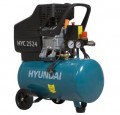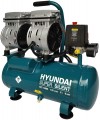Design
The criterion for separating compressors according to this parameter is whether oil is necessary for the normal operation of the device.
—
Oily. Compressors that use oil during operation have a high motor resource (due to the fact that friction in their mechanism is reduced due to the presence of lubrication) and a lower noise level than oil-free ones. On the other hand, they are much more difficult to maintain and more expensive to operate. the oil supply has to be replenished periodically; and during operation, such a unit should be located on a flat horizontal surface. In addition, the outgoing air contains tiny drops of oil. Therefore, oil-based devices are poorly suited for certain types of work — for example, in the food industry, where such impurities are unacceptable, the use of special fine filters will be required.
—
Oil free. The main advantage of oil-free models can be called the purity of the exhaust air — it does not contain oil droplets and in most cases does not require additional purification. This makes these compressors perfect for medical, food and paint applications. In addition, they are simpler in design (respectively, in repair), do not require the hassle of providing lubrication, and can work in almost any position. On the other hand, high friction of parts significantly increases wear, which accordingly affects the resource.
Input performance
The amount of air that the compressor is able to process per unit of time; usually stated in liters per minute. Performance, along with pressure (see below), is one of the most important parameters: it is it that primarily determines how compatible the compressor will be with one or another pneumatic tool.
It is worth choosing a model according to this indicator in such a way that it can be guaranteed to “pull out” all the tools that can be connected at the same time. Air consumption is usually directly indicated in the characteristics of each tool, and it is quite simple to calculate the total requirement. However, due to the design features, the compressor must have a certain performance margin; the specific value of this stock depends on a number of nuances.
The main point is that some companies indicate for their units the performance at the outlet (how much air is supplied to the tool), while others indicate at the inlet (how much air the compressor sucks in). Since no compressor is perfect, part of the air is inevitably lost during the compression process, so the amount of air at the outlet will always be less than at the inlet. Accordingly, if the output performance is indicated in the characteristics, a margin of 10-20% is recommended, and if the input is 35-40%.
There are also more complex techniques that allow you to more accurately derive the required performance depending on the characteristics of specific tools; they can be found in...special sources.
Power
The power of the engine installed in the compressor. It is not the main parameter in evaluating the efficiency of the device — here the performance and nominal pressure play a decisive role (see above), and the engine is selected in such a way that its power is sufficient to ensure the claimed characteristics. However, this indicator still has practical significance: in compressors with an electric motor (and there are now most of them; see “Engine type”), the engine power determines the total energy consumption of the device, as well as the requirements for the network where it is planned to connect it (for more details, see “Voltage networks"). In addition, the power of the engine (regardless of its type) must be known in order to calculate the optimal performance value using some special formulas.
For internal combustion engines, power is traditionally expressed in horsepower (hp); you can convert it to watts in this way: 1 hp. = 735 W.
Power
The power of an internal combustion engine installed in a compressor of the appropriate design (see "Type" above), expressed in horsepower.
For the power value in general, see the relevant paragraph below. Here we note that in modern technology, the universal unit of power used for all types of engines is watts. However, horsepower has traditionally been and continues to be used to characterize internal combustion engines, and some users are more comfortable judging power by this designation. Therefore, for models with internal combustion engines, the equivalent power in hp is often also indicated.
Convert watts to hp and vice versa is quite simple: 1 hp. approximately equal to 735 watts.
Rotation speed
The speed of rotation of the compressor motor shaft in normal operation. This parameter, usually, does not affect the efficiency of the unit — the main indicators are still the performance and nominal pressure (see above). At the same time, it allows you to evaluate the design features of the compressor and its durability. The fact is that a higher rotation speed allows the use of fairly simple and inexpensive working mechanisms, but it increases the wear of moving parts and reduces the motor resource. Therefore, a model with a lower number of revolutions is likely to cost more than the "high-speed" version, but it will also last longer (ceteris paribus characteristics — performance, pressure, drive type, design; see all above).
Number of cylinders
The number of cylinders provided for in the design of the compressor; by definition only indicated for reciprocating models (see "Compressor type"). This characteristic is primarily associated with performance indicators (see above). For example, values above 400 L / min among
single-cylinder units are rather rare exceptions; therefore, if you need a high performance reciprocating compressor, you should look into multi-cylinder models. The second application for multiple cylinders is a multi-stage operation scheme (see "Number of stages").
Receiver volume
The receiver is a tank (cylinder) into which compressed air is pumped during operation of the compressor; it is from this cylinder (and not directly from the working mechanism) that it is fed to the connected instrument. The main meaning of such a scheme is that the receiver compensates for pressure unevenness that occurs during the operation of the main mechanism; it does not guarantee absolute constancy, however, all changes occur very smoothly. In addition, energy savings are ensured in this way: part of the time the compressor runs on the stored air from the receiver, and the engine turns on only when the pressure in the tank is significantly reduced to replenish supplies. Therefore, this piece of equipment is practically mandatory, models
without a receiver are extremely rare today.
In general, the larger the volume of the receiver, the less often it will have to be pumped up after the initial filling with compressed air. It is also believed that a volumetric receiver can partly compensate for the lack of compressor performance; however, this moment does not ensure the constant stable operation of the “gluttonous” tool and serves only as a fallback in case of a short-term increase in air consumption. On the other hand, large volumes mean the corresponding dimensions of the tank (and it is already the largest part in most compressors), and the cost of the device increases accordingly. Therefore, when choosing, it is worth observi
...ng a certain balance and choosing a receiver depending on the specifics of the work. For various types of activities there are recommendations, they can be found in special sources. Here we note that for relatively uniform work in time with a small air flow, a small receiver is usually enough, and if peak loads can occur frequently, it is better to choose a larger cylinder.
Some compressors may provide the expansion of the receiver with additional tanks.Design features
—
Frequency converter. This function is used to automatically control the power of the motor in the compressor (see "Motor type"), more precisely, to adjust the speed to the current air consumption and maintain a constant pressure.
In electrical units, in addition to reducing wear and tear and eliminating current surges in the network, such systems provide the most stable air pressure at the outlet, and energy is spent more rationally. At the same time, frequency converters are expensive and take up quite a lot of space; and the advantages mentioned are relevant for heavy professional-grade equipment. Therefore, this function is found mainly among industrial compressors with an operating voltage of 400 V and based on internal combustion engines.
—
Dehumidifier. The purpose of such devices is already clear from the name: they are designed to dry the air at the compressor inlet, that is, to remove excess moisture from it. The need for such a procedure is primarily due to the fact that high humidity adversely affects the state of the compressor: it leads to condensate settling, and it, in turn, contributes to corrosion and the formation of various emulsions, due to which the channels become dirty and the wear of the entire unit increases .
—
Tandem. Devices created according to the "tandem" scheme are actually two compressors on one receiver, connected
...in parallel. This allows you to turn on both compressors at once, or only one of them — in this way you can adjust the power and performance even in those models where special regulators such as a frequency converter (see the relevant paragraph) are not provided at all.
Among the disadvantages are heavy weight, bulkiness and high cost. In addition, the tandem operation scheme is mainly suitable for powerful performant units — otherwise the individual compressors would have to be made too small, and this does not make sense.
— Wheels for transportation. The presence of special transport wheels in the design of the compressor. Modern compressors can be of considerable weight, which would require the participation of several people when carried; wheels, on the other hand, allow you to move even rather weighty devices without problems by the forces of one, in extreme cases — two people.Noise level (LPA)
The sound pressure level in decibels at a certain distance between the noise source and the ear of the compressor equipment operator. Since people do not work in the immediate vicinity of the compressor, the parameter will be useful for estimating the noise level at a distance. It is most often measured at a distance of 7 m from a working installation, less often at a distance of 1 m.

